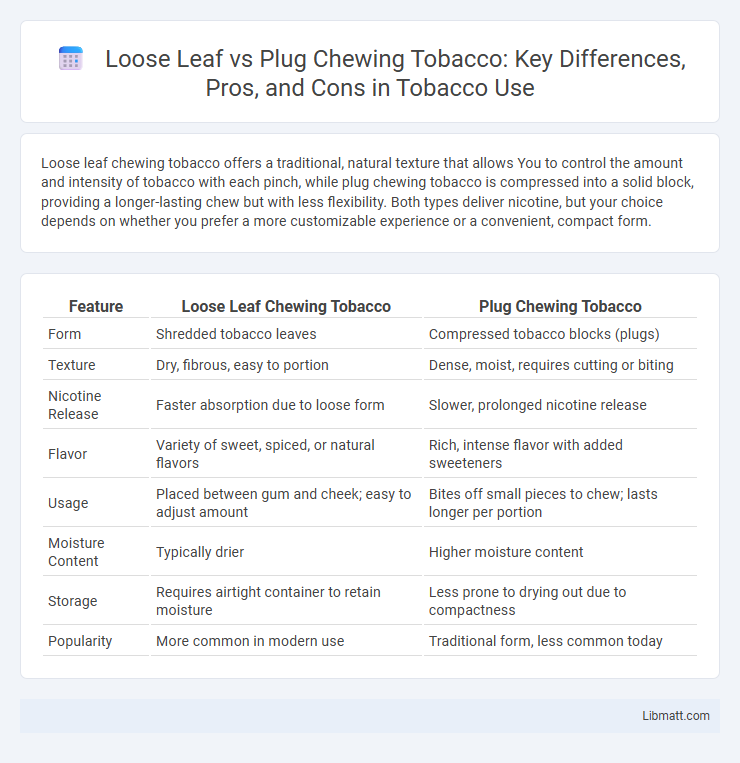Loose leaf chewing tobacco offers a traditional, natural texture that allows You to control the amount and intensity of tobacco with each pinch, while plug chewing tobacco is compressed into a solid block, providing a longer-lasting chew but with less flexibility. Both types deliver nicotine, but your choice depends on whether you prefer a more customizable experience or a convenient, compact form.
Table of Comparison
| Feature | Loose Leaf Chewing Tobacco | Plug Chewing Tobacco |
|---|---|---|
| Form | Shredded tobacco leaves | Compressed tobacco blocks (plugs) |
| Texture | Dry, fibrous, easy to portion | Dense, moist, requires cutting or biting |
| Nicotine Release | Faster absorption due to loose form | Slower, prolonged nicotine release |
| Flavor | Variety of sweet, spiced, or natural flavors | Rich, intense flavor with added sweeteners |
| Usage | Placed between gum and cheek; easy to adjust amount | Bites off small pieces to chew; lasts longer per portion |
| Moisture Content | Typically drier | Higher moisture content |
| Storage | Requires airtight container to retain moisture | Less prone to drying out due to compactness |
| Popularity | More common in modern use | Traditional form, less common today |
Introduction to Chewing Tobacco Types
Chewing tobacco primarily exists in two forms: loose leaf and plug, each offering distinct textures and usage experiences. Loose leaf tobacco consists of shredded leaves that are easy to portion and manipulate, providing a more customizable chew. Plug tobacco is compressed into dense blocks, allowing for longer-lasting flavor but requiring a firmer bite to release its taste.
What is Loose Leaf Chewing Tobacco?
Loose leaf chewing tobacco consists of shredded tobacco leaves that are moist and flavored, designed to be placed between the gum and cheek for slow nicotine release. This type differs from plug tobacco, which is compressed into a solid block and sliced into pieces. Loose leaf varieties often provide a more customizable experience due to their loose, flexible form and variety of flavor options.
What is Plug Chewing Tobacco?
Plug chewing tobacco is a compressed block of tobacco leaves, often sweetened and flavored, designed for slow, extended chewing. Its dense, moist texture contrasts with the finer, loose leaf tobacco, providing a longer-lasting experience. Popular in traditional chewing tobacco markets, plug tobacco requires cutting or slicing before use, offering a robust nicotine release compared to loose leaf varieties.
Key Differences: Loose Leaf vs Plug
Loose leaf chewing tobacco consists of shredded tobacco leaves that are easy to portion and offer a smoother, more flexible chewing experience, while plug tobacco is pressed into a dense, solid block that requires cutting or biting into manageable pieces. Loose leaf varieties typically contain higher nicotine levels due to increased surface area, enhancing flavor release and absorption. Plug tobacco often has a longer-lasting chew and firmer texture, favored by users seeking prolonged flavor and strength.
Flavor Profiles and Experience
Loose leaf chewing tobacco offers a rich, robust flavor profile with natural tobacco sweetness and a leafy texture that provides a traditional chewing experience. Plug chewing tobacco is denser and more compressed, delivering a longer-lasting, intense flavor often enhanced with added sweeteners or spices. Your choice between loose leaf and plug largely depends on whether you prefer a quick, milder chew or a prolonged, more concentrated taste and experience.
Usage and Preparation Methods
Loose leaf chewing tobacco requires users to pinch a portion and place it between the gum and cheek, allowing for gradual flavor release, while plug tobacco is pressed into a firm block that is cut or bitten off before use, offering a longer-lasting chew. Preparation for loose leaf involves simply tearing or folding the leaves into suitable portions, whereas plug tobacco may require softening or slicing to ease handling and consumption. Both types demand spitting due to saliva production, but plug tobacco's compact form often results in a more controlled and consistent experience.
Nicotine Content Comparison
Loose leaf chewing tobacco typically contains higher nicotine levels per gram compared to plug tobacco, making it a stronger option for users seeking more intense nicotine delivery. The nicotine content in loose leaf ranges from 6 to 8 mg per gram, while plug tobacco generally contains about 4 to 6 mg per gram. This variation influences user preference based on desired potency and consumption method.
Health Risks and Concerns
Loose leaf chewing tobacco generally poses higher health risks due to its higher nicotine content and greater potential for oral tissue exposure, increasing the likelihood of gum disease and oral cancer. Plug chewing tobacco, while also harmful, tends to be less abrasive but still carries significant risks of addiction, leukoplakia, and other oral health issues. Protecting your oral health requires understanding that both forms contribute to long-term health concerns, including cardiovascular problems and potential carcinogenic effects.
Popular Brands and Availability
Loose leaf chewing tobacco is widely available from popular brands like Levi Garrett, Red Man, and Stoker's, known for their long-standing presence in the market and classic flavor profiles. Plug chewing tobacco, favored by brands such as Beechnut, Copenhagen, and Havana Red, offers a denser, more compact form that appeals to users seeking a slower, longer-lasting chew. Availability of both types spans convenience stores, tobacco shops, and online retailers, with regional preferences influencing the prominence of specific brands and formats.
Choosing the Right Chewing Tobacco for You
Loose leaf chewing tobacco offers a traditional, natural feel with larger, moister leaves that provide stronger flavor and longer-lasting nicotine release. Plug chewing tobacco is compressed and often flavored, making it more convenient to portion and easier to store without drying out. Understanding your preference for texture, flavor intensity, and usage frequency will help you choose the right chewing tobacco for your experience.
loose leaf vs plug chewing tobacco Infographic

 libmatt.com
libmatt.com